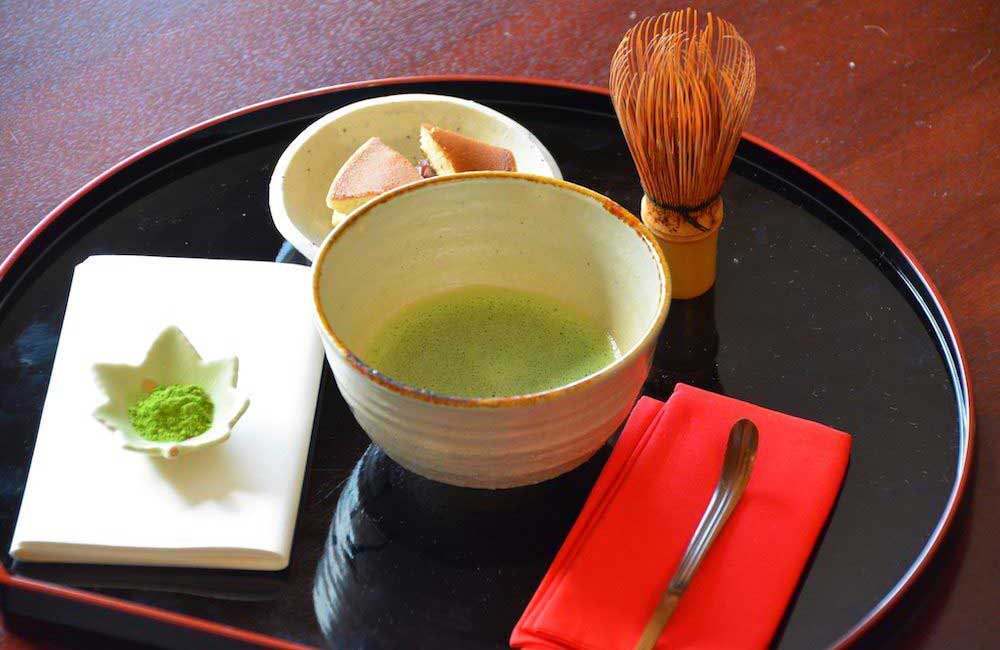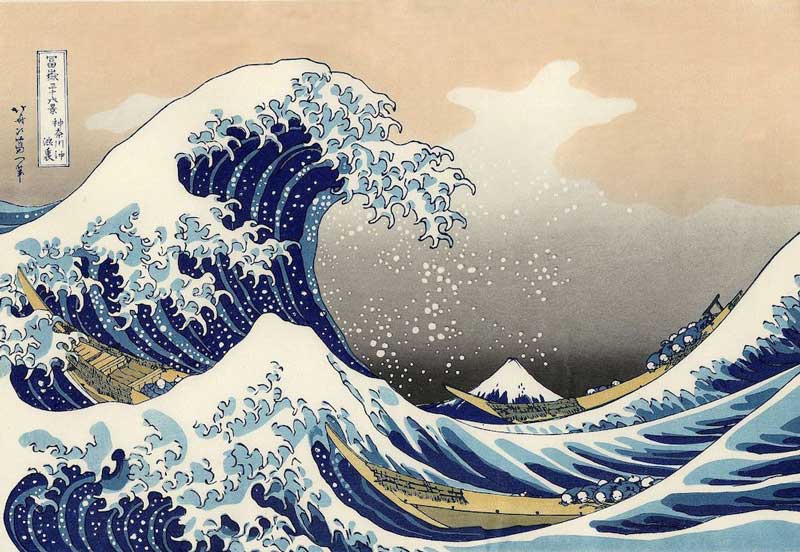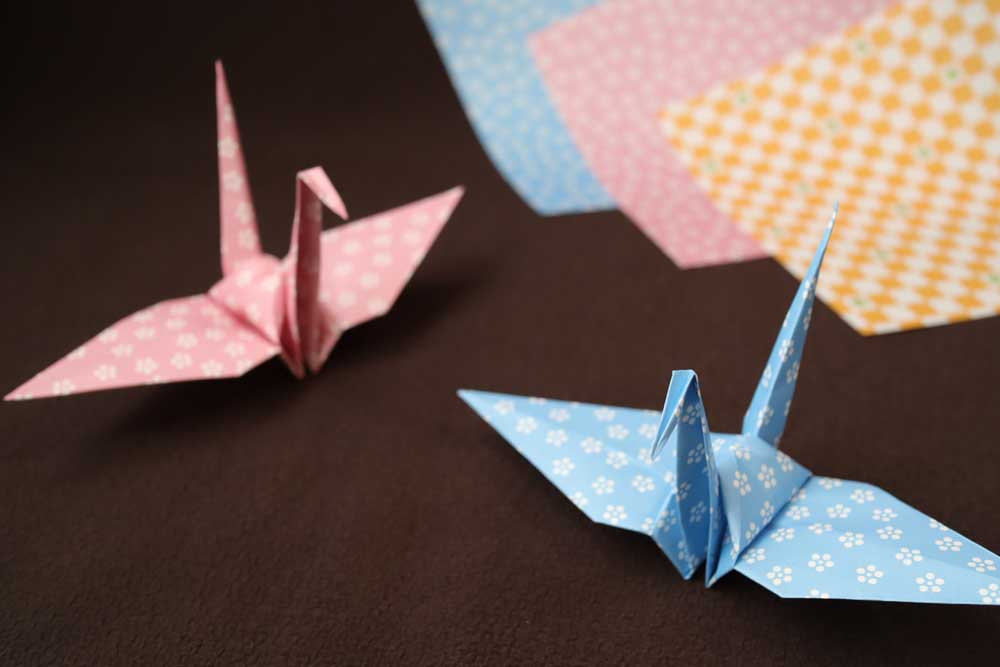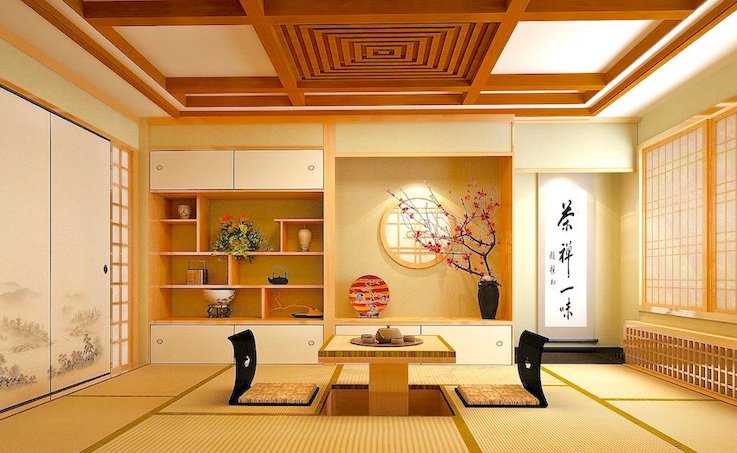
今回は、島国の気候風土に合わせて工夫がこらされた美しい日本の家や和室を英語で紹介する表現をご紹介していきます。
ご興味のある方は、当サイトで 英語クイズ(5000問)を出題しておりますので是非ご覧ください。
目次
日本家屋の簡単な説明
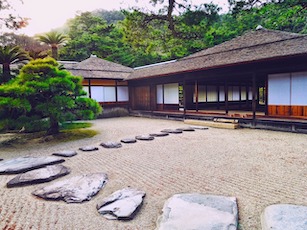
Traditional Japanese houses are basically made of wood and paper.
(日本の伝統的な家は、基本的に木と紙でできています。)
Traditional Japanese houses are made of wood and the structure of the house is built with wooden posts, beams, and girders on a stone foundation.
(日本の伝統的な家は、石の土台の上に木の柱や梁、桁などで骨組みをつくる木造住宅です。)
In Japan, as temperature and humidity vary in the four seasons, many techniques are exercised in building houses so that they can adjust to the changeable climate.
(四季によって温度や湿度が変化する気候風土に適応できるように、多くの工夫が施されています。)
For example, rooms are set 20−30 cm above the ground, flooring rush mats (tatami) cover floors of wooden boarding, and shoji (sliding paper door) and fusuma (sliding paper screen) are used as partitions.
(例えば、部屋は地面から20〜30センチ高く、板張りの床の上に畳が敷かれ、仕切りには障子や襖が使われています。)
The outer wall is made by plastering a wooden base.
(外壁は木でつくった下地に漆喰を塗ります。)
Tatami and plaster are suitable for the Japanese climate because they control humidity by absorbing and releasing moisture.
(畳や漆喰は調湿作用があるので、日本の気候に適しています。)
Japan is hot and humid in summer, cold in winter, has a rainy season, and is dry in fall. Japanese houses are built with all kinds of tricks in mind to adapt to the local climate.
(日本の夏は蒸し暑く、冬は寒く、梅雨があり、秋は乾燥しています。日本の家は、これら地域の気候に適応するためにあらゆる工夫によって建てられています。)
畳
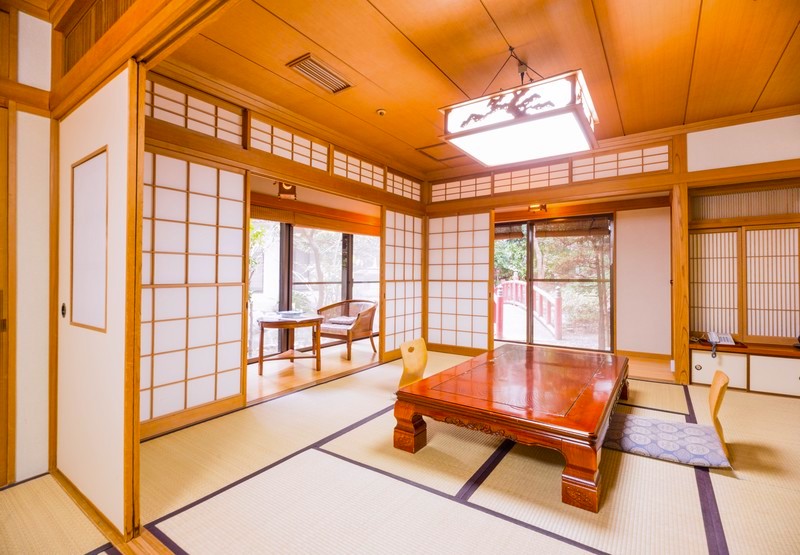
Tatami is a traditional Japanese mat made of bundled rice straw with a surface of woven rushes. Trimming called “tatami-beri” is stitched to the edges.
(畳とは、稲藁の畳床に藺草を編んだ畳表をかぶせた日本の伝統的な敷物です。畳縁と呼ばれるふちが施されています。)
Tatami is a type of mat used to cover the floor in a Japanese-style room called “washitsu.”
(畳とは、和室に敷かれているマットのことです。)
Tatami is made of compressed rice straw covered with woven rushes and attached with brocade or nylon to the long edges.
(畳は、稲藁を圧縮して固めた土台に藺草で編んだ畳表をつけ、金襴やナイロン製の帯状のへりを縫いつけたものです。)
Tatami mat is made of rice straw bundled in layers that are stitched together, and the surface is covered with tightly woven rushes.
(畳は藁の束を重ねて縫い合わせ、その畳床の上に藺草でしっかり編んだ畳表をかぶせて作られています。)
Tatami consists of a thick straw base called “tatami-doko” and a soft, finely woven rush cover with cloth borders.
(畳は、「たたみ床」と呼ばれる太い藁の土台と、柔らかく細かく織った藺草を布で縁取りして作られています。)
Rug-like tatami are mentioned in Kojiki, but it is said that tatami have been shaped like they are now since around the Heian period.
(古事記には畳のような絨毯の記載がありますが、今のような形状になったのは平安時代頃からだといわれています。)
The size of a tatami mat varies slightly by region in Japan, but a standard tatami mat is about 1.8 meters by 0.9 meters or about 5.9 feet by 3.0 feet.
(畳の大きさは日本の地域によってわずかに差がありますが、基本的な畳は1.8メートル×0.9メートルです。)
In Japan, the size of a room is often measured by the number of tatami mats, and one “jo” (畳) is the size of one tatami mat.
(日本では、お部屋のサイズを畳の数で表すことがよくあり、「一畳」は畳一枚です。)
“Jo” (畳) is used to calculate room size by referring to how many tatami mats will fit in a room.
(「畳」は、お部屋が畳何枚分の大きさかを計算するために使います。)
“Jo” (畳) is used as a counter to determine the size of rooms.
(「畳」は、畳を何枚置けるかでお部屋の広さを示す単位です。)
A four-and-a-half-mat room is a square room with its origins in the tea ceremony.
(正方形の4畳半は茶室の大きさがもとになっています。)
You don’t wear shoes or slippers on the tatami floor.
(畳の上では、靴もスリッパも履きません。)
障子
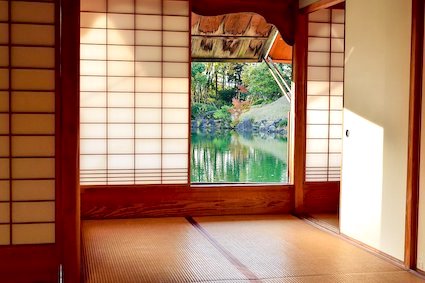
障子も襖も sliding paper door 「紙の引き戸」で表せますが、お部屋の仕切りの意味で使う場合は screen を使います。
Shoji is a sliding screen made of latticed wood into which white Japanese paper is pasted.
(障子は、木の枠に白い和紙を貼り付けた格子状の間仕切りです。)
Shoji is a sliding door made of a wooden latticework frame on which Japanese paper is pasted and used as a room divider or as a window shade.
(障子とは、格子の木枠に和紙を貼り付けた引き戸で、間仕切りや窓の日除けに使われます。)
It is used not only as a door but also to partition rooms.
(ドアだけでなくお部屋の仕切りとしても使われます。→ この partition は「仕切る」という動詞です)
Shoji is a sliding screen with wood latticework built into a rectangular wooden frame and pasted with Japanese paper.
(障子は、長方形の木の枠に、格子状の細い木を嵌め込み、和紙を貼った間仕切りです。)
Shoji is a sliding door, window or room divider used in a traditional Japanese room, consisting of translucent paper stretched over a wooden lattice frame.
(障子はと、日本の伝統的な部屋で使用される引き戸、窓、または部屋の仕切りで、木製の格子フレームに半透明の紙を貼ったものです。)
Shoji is a sliding screen used in a traditional Japanese room, consisting of Japanese papers on a lattice frame.
(障子は、日本の伝統的な部屋で使用される間仕切りで、格子状のフレームと紙でできています。)
Even when shoji are closed, soft light flows/comes through the shoji paper.
(障子を閉めていても、障子紙を通して柔らかい光が差し込んできます。)
Shoji paper pasted on the latticework enables light to penetrate by moderately blocking direct sunlight.
(格子に貼られた和紙が、直射日光を適度に遮り、光を優しく通してくれます。)
A moderate amount of light comes in through the shoji paper in the daytime, and the inside can not be seen from the outside.
(昼間は障子紙を通して適度な明かりが入り、外からは中が見えません。)
Shoji is ideal for the climate in Japan because it has the ability to control the level of humidity in homes and prevents condensation from forming on the windows during winter.
(障子紙が日本の気候にとって理想的なのは、家の湿度を調節し、冬の窓に結露が発生するのを防ぐことが出来るからです。)
襖(ふすま)
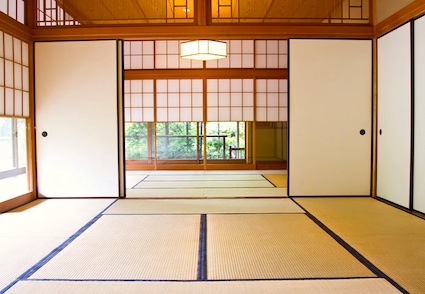
a sliding door covered with thick paper on a wooden frame
(木の枠に厚い紙を貼った引き戸)
Fusuma are fittings made by covering both sides of wooden frames with durable Japanese paper.
(襖は木枠の両面に丈夫な和紙を貼った建具です。)
Fusuma are wooden panels about the same size as a tatami mat and 3 cm thick, covered with durable paper.
(襖は畳と同じくらいの大きさで、3センチの厚さの木の板に丈夫な紙を貼ったものです。)
They are used to partition flooring tatami mat rooms and as doors for closets (oshiire).
(畳の部屋を仕切ったり、押し入れの戸として使ったりします。)
Unlike shoji, fusuma gives rooms more privacy than shoji would allow.
(障子よりも襖のほうがプライバシーが守られます。)
The beautiful designs and paintings on this paper create a superb interior.
(襖には美しい模様や絵が描かれているため、優れたインテリアになります。)
床の間

「床の間」は、alcove を使えばどういう空間なのかイメージしてもらえます。
- wooden-floored alcove in a tatami room
- raised alcove in a Japanese room
alcove は、室内の壁面に作られたくぼみ または 外側に張り出して作られた付属的な小部屋で、日本の床の間は大体半畳から一畳くらいですが、海外の alcove はかなり広い場合もあります。
“Tokonoma” is a space in a tatami room that is a step higher than the rest of the room and has a wooden floor.
(床の間とは、座敷より一段高くなった板敷きの空間です。)
Tokonoma is a raised alcove in a tatami room in which items are displayed for artistic appreciation.
(床の間は、和室の壁に作られたくぼみで床より高く、芸術的鑑賞のための物を置く空間です。)
Tokonoma alcove is about the size of one or a half tatami and is set into one wall of Japanese-style rooms.
(床の間は、和室の壁面に設けられた部分で、一畳または半畳くらいの広さです。)
Tokonoma is a place to hang scrolls or display items such as ikebana (flower arrangements), bonsai (potted trees), a favored piece.
(床の間は掛け軸を掛けたり、生け花、盆栽などの好きなものを飾ったりします。)
Flowers, scrolls, or ornaments are displayed in the tokonoma.
(床の間には、お花や掛け軸、置き物などを飾ります。)
It was originally considered a sacred place in which to put a statue of Buddha.
(もともとは仏像を安置する神聖な場所でした。)
We put “kakejiku” (hanging scrolls) on the wall and display flowers or ornaments on the floor.
(壁には掛け軸を、お花や盆栽などを飾ります。)
押し入れ
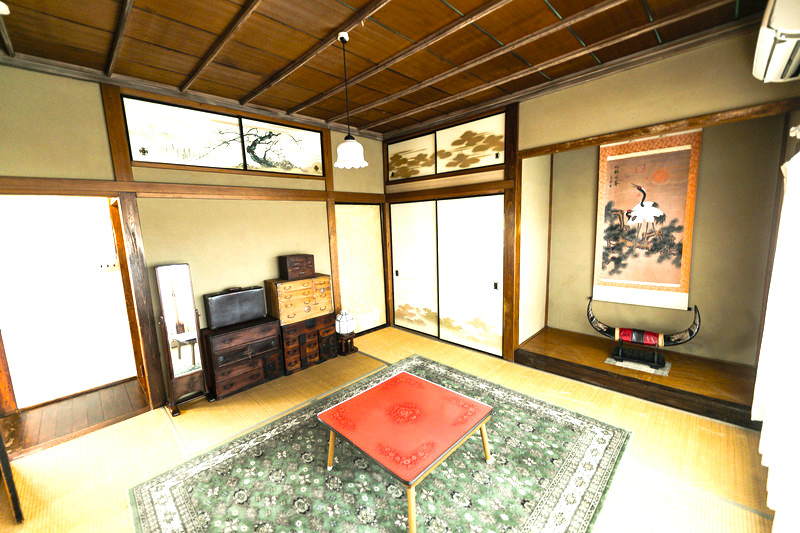
Bedding or cushions are stored inside the oshiire.
(押し入れには寝具や座布団などを収納します。)
Oshiire is a closet for sleeping quilts (futon) and seat cushions and is usually a built-in fixture in a tatami room.
(押し入れは寝具や座布団を入れておく収納室で、和室にはたいてい備えつけられています。)
Most tatami rooms are provided with one or more built-in closets (oshi-ire) with sliding fusuma doors.
(たいていの和室には、襖のついた押し入れがひとつは設えてあります。)
縁側
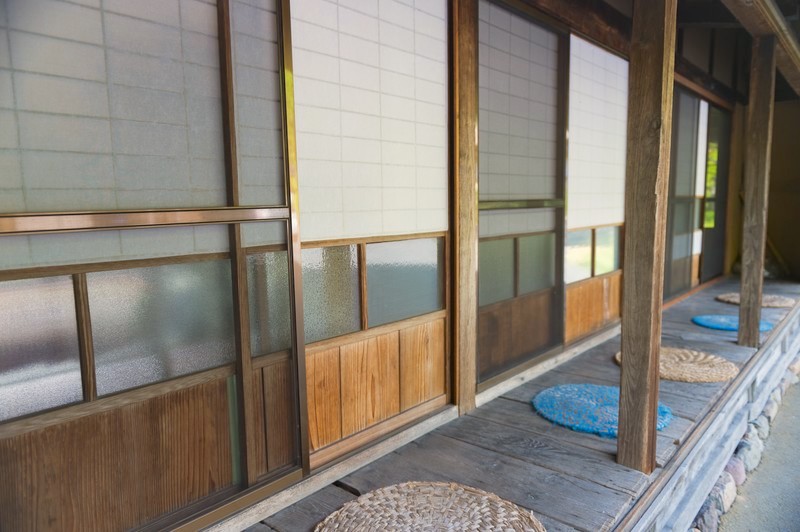
縁側は、narrow wooden deck などと訳されます。
“Engawa” is a corridor with a wooden floor outside of tatami rooms.
(縁側は座敷の外側に設けられた板敷の回廊。)
Rooms located on the first floor of a traditional Japanese house often have engawa.
(伝統的な日本家屋の一階の部屋には、よく縁側が設けられています。)
As there are projecting eaves above the engawa, it stays dry during rain, even when the sliding doors are open.
(縁側の上には庇が張り出しているため、引き戸を開けておいても雨に濡れません。)

